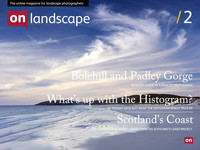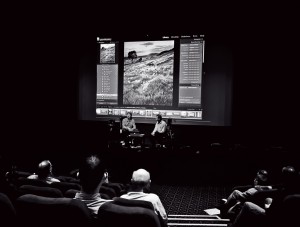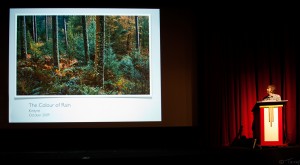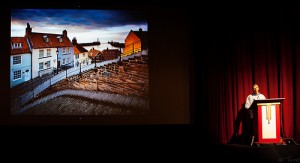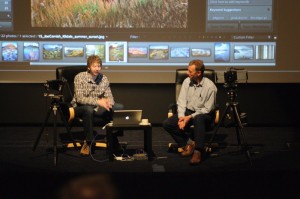Photocamp hosts the launch of On Landscape

Tim Parkin
Amateur Photographer who plays with big cameras and film when in between digital photographs.
As I had mentioned in the news from the previous issue, Joe and I gave a interactive session at the National Media Museum on the 16th of October as part of the Photocamp project. The talk was ostensibly about film and digital but we quickly meandered around a few different topics as questions were asked from the audience.
I'll come back to the points we were talking about and try to flesh them out for those in the audience who were interested in hearing the whole lots. However, that really deserves something a little longer so perhaps next issue. In the meantime, I want to try to expand on the question asked from the audience about using HDR or Graduated Filters.
The short answer, as usual is 'it depends' but closely followed by 'graduated filters'. Now this is possibly a bit of a cop out but I think we both have a feeling that fully automated HDR is mostly a bad approach. Now there are situations where it works fine and obviously, when it works fine, it works fine. However, there are many more situations where the results are not particularly satisfying and to understand why, we need to know a little about what HDR is actually doing.
HDR photography is actually two steps, the HDR step - where multiple photos are combined to give a High Dynamic Range picture - and then a compression step which reduces this high dynamic range into a smaller range that can be shown in a print or on a monitor.
The HDR step is fairly consistent, with the main variable being the number of pictures and width of exposure bracketing. I don't want to go into detail here as I'm interested in a separate article on this at some point (and I'm not confident enough in my hunches yet).
The compressions step is a lot more interesting and is where there are a whole swathe of techniques to combine results. The typical HDR is 'adaptive' and tries to ensure that within a certain radius, there is a highlight and a dark area (ok there are a lot more versions than this but this was the original version). The problem with this is that very often, within a radius you just have highlights, or in other parts of the picture, you actually want dark shadow. Allowing an automated procedure to handle this means losing control over your exposure. Wider radiuses can help but the problems can still occur. In addition, some of the highlights in the image can end up over saturated as they are dynamically reduced in brightness. These two contribute to a sense of cognitive dissonance (brain stress) where areas in the foreground or in shadow end up brighter than areas in direct sunlight or even the sun itself!
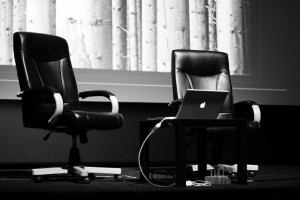
The Photo Boy - Flickr
The key to believable contrast reduction is to keep as much of the general contrast differences in the picture as possible, placing your compensations either gradually over a larger area or if this is impossible, place them along areas that are believable. e.g. the classic hard grad over the horizon because people don't have a strong mental image of what brightness levels next to the horizon do, hence we can move these levels around without confusing people.
All of these techniques come down to 'contrast management' and the best form of contrast management is choosing when and where to take the picture. An example I used in the presentation is shown below where I avoided direct sunlight (where the result was reduced saturation and little 'modelling light') and also avoided taking pictures in full shade (where the picture looked drab and shapeless) and took the picture in between the two, just as a cloud drifted over the sun. This gave a reduced contrast range but kept a little diffuse light from the sun which provided wonderful colour saturation but still kept some directional light which 'modelled' the subject nicely.
A good result is where you use this contrast management in combination with either a subtle graduated filter (2 stop hard or 3 stop soft for instance) or a couple of brackets. The nice thing about using graduated filters is that you can quickly see the effect, you know that you are going to get a believable result.
I often use a combination of the three, choosing good light to reduce contrast, adding a medium level graduated filter (avoiding 3 stop hard unless against a straight horizon, choosing a 2 stop hard and 2 stop soft in preference if really pushed). I then take a shot that holds the brightness range and maybe take a shot a couple of stops over to allow me to 'fill the shadows' if necessary later. This way I get a working shot straight out of the camera and a supporting shot I can use if the shadows are blocked up or noisy.
If you have a very complicated shape (such as the classic V shaped valley at sunset) taking multiple exposures is inevitable. However, when processing them you need to remember that people know what the gradients of light in a sky should look like and hence blending your shots in the sky will not look as believable.
So I think our recommendation is probably to use graduated filters to get close and then bracket to allow you to blend these if necessary (i.e. use all the tools at your disposal).
We also had a question about 'available light' photography - as in 'do you always use it'. To which Joe quoted XX by saying "flourescent, flash, candles .. if it's available, I'll use it". To be a little more serious, Joe said he was happy to use artificial light and has done in quite a few photographs in print (in the Northumberland Coast for instance). I haven't done so, but I have spent a while thinking about using some form of artificial lighting; a plan to find some pools in the wilderness and create a diorama with a few different diffuse lights - although I can't imagine getting this done without help. I think the conclusion is that the light had to be 'natural looking', if not natural.
A final question came from Jason Theaker and was one that I have an interest in digging a bit deeper into at some point. The question was 'do you take pictures inspired by or homeages of other photographers and how do you feel when people do it to you'. Joe, after a moments hesitation, said that despite his family feeling quite strongly about it, taking a reasonable amount of umbrage when inspiration infringes on plagiarism, he doesn't get too stressed about it. He admits that he has taken pictures, homages of photographers from Ansel Adams through Peter Dombrovskis to Paul Wakefield. And talking to Joe after the event, he said he would love to talk about this more so it will definitely make it into another episode. Perhaps we can go and pay homage to some of the UK's early landscape photographers sometimes (the George Washington Wilson, )

